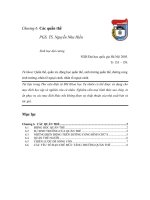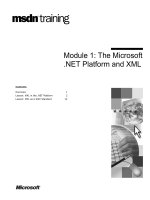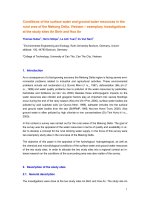Tài liệu Drilling Down: The Gulf Oil Debacle and Our Energy Dilemma pot
Bạn đang xem bản rút gọn của tài liệu. Xem và tải ngay bản đầy đủ của tài liệu tại đây (5.48 MB, 253 trang )
Drilling Down
wwwwwwwwwwwww
Joseph A. Tainter
L
Tadeusz W. Patzek
Drilling Down
The Gulf Oil Debacle
and Our Energy Dilemma
Joseph A. Tainter
Department of Environment and Society
Utah State University
Logan, UT 84322 USA
Tadeusz W. Patzek
Department of Petroleum
and Geosystems Engineering
The University of Texas at Austin
Austin, TX 78712 USA
© Springer Science+Business Media, LLC 2012
All rights reserved. No part of this publication may be reproduced, stored in a retrieval system, or transmitted,
in any form or by any means, electronic, mechanical, photocopying, recording, or otherwise, without the prior written
permission of the publisher.
Published in the United States by Copernicus Books,
an imprint of Springer Science+Business Media.
Copernicus Books
Springer Science+Business Media
233 Spring Street
New York, NY 10013
www.springer.com
Library of Congress Control Number: 2011935227
Manufactured in the United States of America.
Printed on acid-free paper
ISBN 978-1-4419-7676-5 e-ISBN 978-1-4419-7677-2
DOI 10.1007/978-1-4419-7677-2
In memory of Anne O’Rourke
– JAT
For my wife, Joanna, and my children, Lucas, Sophie,
and Julie
–TWP
wwwwwwwwwwwww
vii
Acknowledgments
It is a pleasure to acknowledge the many people who encouraged us and
helped with this book. Myrna and Charles Hall of the State University of
New York at Syracuse suggested that we write it, and this project would not
have been undertaken without their foresight. Joyce Vandewater prepared a
number of illustrations, excellently as always. Steve Balogh kindly provided
the data for Fig. 5.9.
Joseph Tainter is particularly pleased to acknowledge the support and
sharp observations of his wife, Bonnie Bagley, who has been a true intellec-
tual partner in all of his work.
Tad Patzek would like to thank Dr. Paul Bommer of the University of
Texas, Austin, for numerous discussions, corrections, and help with the vari-
ous technical aspects of the Macondo saga. He also wants to thank his son,
Lucas, for ample feedback and editorial suggestions, and his wife, Joanna, for
saintly patience.
Finally, it is a particular pleasure to thank Dr. David Packer for being the
best editor either of us has worked with. David improved the text greatly, and
if what you see here achieves its purpose, it is largely thanks to him.
wwwwwwwwwwwww
ix
Contents
1 Introduction 1
2 The Significance of Oil in the Gulf of Mexico 7
3 The Energy That Runs the World 23
4 Offshore Drilling and Production: A Short History 53
5 The Energy-Complexity Spiral 65
6 The Benefits and Costs of Complexity 97
7 What Happened at the Macondo Well 135
8 Why the Gulf Disaster Happened 159
9 Our Energy and Complexity Dilemma: Prospects
for the Future 185
Appendix A: Glossary 215
Appendix B: Offshore Production 219
Appendix C: Operating an Offshore Platform 231
About the Authors 235
Index 239
1
1
J.A. Tainter and T.W. Patzek, Drilling Down: The Gulf Oil Debacle
and Our Energy Dilemma, DOI 10.1007/978-1-4419-7677-2_1,
© Springer Science+Business Media, LLC 2012
Chapter 1
Introduction
We begin this book during the Fourth of July weekend, 75 days after the
Deepwater Horizon exploded, burst into flames, and sank, killing 11 men.
In the wake of this accident came the worst environmental disaster in U.S.
history. The starting date of our writing is significant because this is a weekend
when normally thousands of people would descend on the beaches and
restaurants of the Gulf Coast. The Gulf is a place of great bounty. A couple
of hours with some traps produces enough blue crabs to make a cauldron of
gumbo that can feed a family and guests for days. Order crayfish (“craw-
dads”) at the right season and your table will be piled high with them. All of
this, and the livelihoods that depend on it, is now lost over large areas.
Because of how tightly connected our economy and society are, it is not
hard to foresee many of the consequences. As the owners of boats, restau-
rants, and motels lose business, they lay off employees and pay less tax. The
suppliers with whom they do business suffer the same in connections that
extend across the country and across the oceans. Oil on a beach means local
restaurants serve less beef from Kansas, fewer chickens from Arkansas, and
fewer vegetables from California. Those restaurants order fewer serving plates
from overseas, and motels order fewer sheets, and less detergent to wash the
sheets. Employees laid off will not be buying new cars or wide-screen televi-
sions, eating out, or replacing a washing machine. Church donations are
already down. With reduced taxes, state and local governments will hire fewer
teachers or police officers. Such connections could be traced on and on. BP,
the company that leased the Deepwater Horizon, has stated that it will pay
2 1 Introduction
all claims, but there are limits to that commitment. Can a vegetable grower
in California expect compensation for fewer shipments to Gulf Coast restau-
rants? What about a vegetable farmer in Mexico, or a fruit grower in Chile?
Can a seafood restaurant in Albuquerque or Denver expect compensation
because shrimp and oysters from the Gulf are scarcer and more expensive?
For that matter, what about companies such as Zatarain’s, which produces
spices for New Orleans cuisine, or Café du Monde, a local coffee shop and
producer of a special coffee blend? At some point people, businesses, and
governments hurt by the spill will have to absorb their losses.
There are also losses that cannot be counted in money, and these may be far
more tragic. A few years ago, a colleague in economics, George Peterson of the
U.S. Forest Service’s Rocky Mountain Research Station, was asked to help
determine compensation for damages from the Exxon Valdez oil spill in southeast
Alaska. There, as in the Gulf, people accustomed to a life of fishing suddenly
lost their livelihoods. The surprise was to discover that these people could not
be adequately compensated with any amount of money. People had lost a way
of life that gave meaning and value. How do you compensate people who have
lost their sense of worth, their identity? Quite simply, you cannot. As it was in
the Alaska spill, so it is in the Gulf. Money may be necessary, but it cannot
compensate for what has been lost. And knowing the people of the Gulf, we
are certain that they do not want to spend years living off payments from BP.
Then there is the natural ecosystem itself, the marshes and beaches, the
fish, birds, and mammals, and the once-blue water. Beaches can be cleaned,
but you cannot restore a complex system. Nature must do that, and will, but
the process may take decades. This is the most important restoration of all.
All else in the Gulf – businesses, jobs, taxes, church donations, a way of life –
depend on this natural system.
A great deal has been written about the Gulf spill in articles, books, and
online. Much of this, however, repeats the obvious observations about our
dependence on oil, energy independence, the desirability of clean energy, and
the failures of regulation. Although we do not downplay the importance of
these matters, such points are already known. Within the Gulf tragedy there
are deeper lessons about energy, about our society, about how we came to be
both so complex and so dependent on fossil fuels, and about what this means
for our future. It is clear that the Gulf tragedy and its aftermath constitute a
period in time when important lessons can be drawn and learned, and a
moment when we will be open to introspection about oil and a society that
requires such great quantities of this nonrenewable resource. The late anthro-
pologist Leslie White once noted that a bomber flying over Europe during
31 Introduction
World War II consumed more energy in a single flight than had been
consumed by all the people of Europe during the Paleolithic, or Old Stone
Age, who existed entirely by hunting and gathering wild foods. White estimated
that such societies could produce only about 1/20 horsepower per person, an
amount that today would not suffice for even a fleeting moment of industrial
life. Our societies today need such vast amounts of energy that we provide it
by mining stocks of solar energy accumulated eons ago, and converted into
coal, natural gas, and petroleum. Without these stocks we could not live as we do.
Is it realistic to think that we can simply rely forever on today’s energy
sources? Groups such as the Association for the Study of Peak Oil and Gas
(ASPO) warn that we will soon reach a point known as “peak oil.” When this
point is reached, oil production cannot be increased, even when there is plen-
tiful oil in the ground. In fact, once production starts to decline, each year
thereafter the world will need to get by on less oil than the year before. The
date of reaching peak oil is controversial. The U.S. Army once predicted that
it would be 2005, and some analysts – including one of the authors – think
that indeed we reached it then. If so, the effects have been masked by the
current recession and the development of previously unreachable oil deposits,
such as in deep water. The simple answer is that we do not know exactly if
peak oil has been reached, nor how long global oil production would hover
at a level close to the peak. The only certainty is that the global peak of oil
production is closer each day.
The Roman poet Juvenal wrote that “a good person is as rare as a Black
Swan.” Until 1697, when black swans were found in Australia, they were
thought not to exist. All swans observed by Europeans had been white. The
term has come to mean something that has never been observed, and is consid-
ered either impossible or highly unlikely. As explained by Nassim Nicholas
Taleb, nothing in the past convinces us that a black swan can exist. Was the Gulf
spill a Black Swan, something that was highly unlikely to happen? Nothing like
it had occurred in America’s waters, not even the Exxon Valdez spill. Most people,
and clearly the regulatory authorities, thought that such a catastrophe could not
happen. Yet there have actually been several times when we averted such spills
because the blowout preventer, which failed in the Deepwater Horizon case, did
work. Such events point to a systemic problem, and suggest that the spill
was in fact likely given sufficient opportunities and time.
There is, however, still a sense in which the Black Swan metaphor is useful
here. One important aspect of Black Swan events is that they give us an
opportunity to see the world in a new light, to discard outdated assumptions
and question what we have thought. Our society rarely thinks about our
4 1 Introduction
energy supply, or how that supply brings food to our tables, clothing and
consumer goods to stores, loans for cars and houses, and taxes for the govern-
ment. Even donations to churches depend ultimately on petroleum. Our
ignorance of energy has been like the one-time ignorance of Europeans
about swans. Economists treat energy as a commodity, no different from
bananas or iPods, to be produced and sold in relation to market demand.
Peak oil, and the resulting imperative to drill deeper and more remotely to
find new oil, not only gives us the opportunity to look at the assumptions in
our lives, but also the larger societal processes that result from what we call
the energy–complexity spiral.
Toward the end of World War II, Vannevar Bush, director of the wartime
Office of Scientific Research and Development, submitted a report to
President Truman entitled Science, the Endless Frontier. President Roosevelt had
requested the report because of the great contribution of science to the war
effort. In the report, Bush wrote that
Advances in science will…bring higher standards of living, will lead to the
prevention or cure of diseases, will promote conservation of our limited national
resources, and will assure means of defense against aggression.
Nearly 65 years later, Secretary of Energy Steven Chu voiced nearly the
same optimism. “Scientific and technological discovery and innovation,” he
testified before Congress in 2009, “are the major engines of increasing pro-
ductivity and are indispensable to ensuring economic growth, job creation,
and rising incomes for American families in the technologically driven
twenty-first century.” Both statements reflect an enduring facet of American
life: our optimism that technology will solve today’s problems and provide a
better future. The Deepwater Horizon was an expression of that optimism
and, until it exploded and sank, it might have given comfort that the opti-
mism was warranted.
Yet the Deepwater Horizon shows both the strengths and the weaknesses
of our reliance on technology. Humans have been using petroleum products
for 5,000 years, and in that time we have exploited the most accessible
sources, those easiest to find and bring into production. As we exhaust the
easiest sources, we turn to deposits that are less accessible and costlier to
obtain. In the early 1930s, the Texas Co., later Texaco (now Chevron) devel-
oped the first mobile steel barges for drilling in the brackish coastal areas of
the Gulf of Mexico. In 1937, Pure Oil (now Chevron) and its partner
Superior Oil (now ExxonMobil) used a fixed platform to develop a field in
14 feet of water one mile offshore of Cameron Parish, Louisiana. In 1946,
51 Introduction
Magnolia Petroleum (now ExxonMobil) drilled at a site 18 miles off the
coast, erecting a platform in 18 feet of water off Saint Mary Parish, Louisiana.
The Macondo Well was the technological descendent of these, and many
other, early offshore wells.
There is a systematic pattern that links our demand for oil to the com-
plexity of the technology we use to find and produce petroleum, our
economic and energy return on energy production, the complexity of our
society, and our ability to maintain the way of life to which we are accus-
tomed. It takes energy to get energy, to find, extract, refine, and distribute it.
The difference between what we spend and what we get back is called net
energy. It is also known at Energy Returned on Energy Invested (EROEI),
a term that will be even more prominent in the future. As the petroleum we
extract comes from reserves that are more and more inaccessible – a mile
underwater in the case of the Deepwater Horizon – the net energy declines.
While EROEI declines, the technology that we develop to find and extract
petroleum grows increasingly complex and costly. It takes more energy to get
energy, and to develop and run petroleum technology. Deep-sea exploration
rigs are among the most complex technologies that we have developed, and
they are correspondingly costly. The Deepwater Horizon cost about
$1,000,000,000 to build in 2001, and $500,000 a day to operate. For the
past 100 years, abundant and inexpensive energy has fueled tremendous
growth in the size and complexity of our societies, and in the numbers of
people that the earth supports. This energy–complexity spiral means that we
need greater amounts of energy just to stay even, let alone continue to grow.
At the same time, our way of life and the ordinary challenges of living gener-
ate problems that require additional complexity and energy to solve. This
added complexity is not just in the technological sphere, but also in our
institutions, our activities, and our daily lives. The energy–complexity spiral
occurs because abundant energy stimulates and requires more complexity,
and complexity in turn requires still more energy.
Over the last few centuries, this spiral has moved ever upward. The ques-
tion we must confront is: how much longer will this pattern continue? The
spiral moves upward today in the face of greater and greater resistance, that
resistance being the increasing difficulty of getting oil. The Gulf disaster
forces us to confront this dilemma. It makes us see how costly it can be to
pursue petroleum that is ever more remote, and to ask whether we can plan
on a future that requires still more oil. The tragedy in the Gulf shows that
although we need oil for our way of life, oil can also ruin that way of life
directly or through our inability to manage the growing risks associated with
6 1 Introduction
complexity in all areas from technology to business operations to government
oversight. In undertaking to write this book, then, our purposes are twofold:
first to explain the Gulf disaster, the energy–complexity spiral, and how they
are necessarily connected; and second to encourage all consumers of energy
to consider whether this spiral is sustainable, and what it will mean for us if
it is not.
7
Chapter 2
The Significance of Oil in the Gulf of Mexico
It was 9:15 p.m. on April 20, 2010, and the captain of the Deepwater
Horizon was entertaining heavyweights from British Petroleum (BP) and
Transocean, by showing off the computers and software at his disposal. After
the Captain welcomed his visitors on the bridge, Yancy Keplinger, one of two
dynamic-positioning officers, began a tour while the second officer, Andrea
Fleytas, was at the desk station. The officers explained how the rig’s thrusters
kept the Deepwater Horizon in place above the well, showed off the radars
and current meters, and offered to let the visitors try their hands at the rig’s
dynamic-positioning video simulator. One of the visitors, a man named
Winslow, watched as the crew programmed-in 70-knot winds and 30-foot
seas, and hypothetically put two of the rig’s six thrusters out of commission.
Then they set the simulator to manual mode and let another visitor work
the hand controls to maintain the rig’s location. While Keplinger was advising
about how much thrust to use, Winslow decided to grab a quick cup of coffee
and a smoke. He walked down to the rig’s smoking area, poured some coffee,
and lit his cigarette.
1
Most readers will be familiar and comfortable with this narrative. There
was nothing extraordinary about it, as thousands of similar scenes of
human–computer and human–machinery interactions play out every day in
industrial, medical, military, banking, security, or TV news settings.
Everything seemed to be under control, with the computers in charge, and
their sensors humming. The people assigned to watch these computers, and
1
All of these events are documented in the President’s Commission Report, Chap. 1, p. 7.
J.A. Tainter and T.W. Patzek, Drilling Down: The Gulf Oil Debacle
and Our Energy Dilemma, DOI 10.1007/978-1-4419-7677-2_2,
© Springer Science+Business Media, LLC 2012
8 2 The Significance of Oil in the Gulf of Mexico
act on their advice, were content and getting ready to go to sleep. This is who
we have become, and this is the environment in which most of us exist.
Suddenly, all hell broke loose, and it became clear that the people watching
the computer screens did not understand what the computers were telling
them. It took just a few seconds for their false sense of security to go up in
the same flames that consumed the Deepwater Horizon in two days.
Although the outcome was extraordinary, the circumstances were not.
Thousands of computer screens and messages are misinterpreted or misun-
derstood every day, but only occasionally does a mine cave in, a nuclear reac-
tor melt down, a well blow out, a plane crash, a refinery explode, or soldiers
die from friendly fire as a result. Each time we are reassured that the incidents
were isolated and could have been avoided if people were just more thought-
ful, better trained, or better supervised, managed, and regulated. Is this sense
of security justified, a sort of divide-and-conquer mentality where isolated
events appear small and amenable to familiar solutions, or are these events the
result of societal processes over which we have little control?
Why would a company like BP build such a monument to technology and
ingenuity as the Macondo well in the first place? Why was it necessary to drill
for oil one mile beneath the surface of the Gulf of Mexico? Hubris among top
management may have minimized the perception of risk, but well-informed
employees throughout the organization understood the perils as well as the ben-
efits of deep offshore operations. You may think that the need and motivation
for these operations are obvious, but any rationale for drilling in these inhospi-
table environments must take into account the amount of oil (or energy in some
form) that is needed to build and maintain an offshore drilling rig such as the
Deepwater Horizon, extract the oil, and transport, store, and bring the precious
liquid to market. In other words, large offshore platforms are built and operated
using vast quantities of energy in order to find and recover even more. The cost
is still higher when you consider the complex management and regulatory struc-
tures needed to complement the technology, however poorly you may feel that
the responsible people performed in the case of the Deepwater Horizon.
Let us begin with fundamentals. First we need to know how much recov-
erable oil is waiting for us down there, how this amount of oil measures up
against demand and total oil use in the United States, and how big the energy
profit is after so much energy is expended in exploration, drilling, recovery,
refining, and transportation to your local gas station or power plant. In other
words, do the benefits outweigh the risks, for whom, and for how long?
We also need to know something about energy itself. Everybody talks
about energy, but do we really understand its omnipresent role in society?
9How Important Is Oil Production in the Gulf ?
How does our insatiable appetite for energy fuel the growth of technological
and organizational complexity, with all of their attendant benefits and costs?
In this book, you will learn the technological and organizational factors that
led to the disastrous oil spill in the Gulf. We call these factors the proximate
causes. You will also see how energy and complexity can enter a positive
feedback loop and spiral out of control in human societies, which makes
catastrophes on local and regional scales increasingly likely, and can even
threaten the future of our civilization.
How Important Is Oil Production in the Gulf ?
Oil production in the Gulf of Mexico is considered vital to meeting U.S. energy
needs, and thus world energy requirements. We present here some data on the
Gulf oil reservoirs that we know about, those we expect are yet to be discovered,
and those that we think exist but will always be too small to exploit because the
potential economic or energy profit is too small. Oil or gas reserves are the quan-
tities of crude oil or natural gas (total hydrocarbons) we are sure can be recovered
profitably from known accumulations of hydrocarbons. The concept of reserves
implies that oil companies can use “off-the-shelf” technology to get at the
hydrocarbons. In other words, to count as reserves, the hydrocarbons must be
discovered, commercially recoverable, and still remaining. Usually, only 1/3–1/2
of the oil and 3/4 of the gas in place can be recovered economically.
To estimate oil and gas reserves in the Gulf (see Fig.
2.1
), we first have to
define the physical extent of the oil-producing areas in what is known as the
Outer Continental Shelf (OCS). In the U.S. Interior Department’s lingo,
OCS consists of the submerged lands, subsoil, and seabed lying between the
seaward extent of the states’ jurisdiction and the seaward extent of federal
jurisdiction. The continental shelf is the gently sloping undersea plain between
a continent and the deep ocean. The U.S. OCS has been divided into four
leasing regions, one of which is the Gulf of Mexico (GOM) OCS Region.
In 1953, Congress designated the Secretary of the Interior to administer
mineral exploration and development of the entire OCS through the Outer
Continental Shelf Lands Act (OCSLA). The OCSLA was amended in 1978
directing the secretary to:
Conserve the Nation’s natural resources.s
Develop natural gas and oil reserves in an orderly and timely manner.s
Meet the energy needs of the country.s
10 2 The Significance of Oil in the Gulf of Mexico
Protect the human, marine, and coastal environments.s
Receive a fair and equitable return on the resources of the OCS.s
State jurisdiction is defined as follows.
Texas and the Gulf coast of Florida are extended three marine leagues s
(approximately nine nautical miles) seaward from the baseline from which
the breadth of the territorial sea is measured.
Fig. 2.1 The continental shelf of the Gulf of Mexico is topographically diverse, and
includes slopes, escarpments, knolls, basins, and submarine canyons. Ocean water enters
from the Yucatan channel and exits from the straits of Florida, creating the loop current
associated with the upwelling and the high level of nutrient flow of this large marine
ecosystem. Large quantities of freshwater are delivered from rivers in the United States
and Mexico. The Gulf of Mexico is North America’s most productive sea. Its shallow
waters, especially river estuaries, teem with marine life. The region of the Mississippi
River outflow sustains the highest level of marine life in the Gulf of Mexico. Chemical
water pollution, coastal erosion, and overfishing are major threats to the health of this most
important marine ecosystem in North and Central America. The Gulf of Mexico region
is also a major oil and gas province that delivered 1.5 million barrels of oil per day for
the United States in 2009. (Sources: NOAA, Minerals Management Service (MMS))
11How Important Is Oil Production in the Gulf ?
2
Jean Laherrère, Distribution of field sizes in a petroleum system: Parabolic-fractal,
lognormal, or stretched exponential?, Marine and Petroleum Geology, 17 (2000), 539–546.
Louisiana is extended three imperial nautical miles (imperial nautical s
mile = 6,080.2 feet) seaward of the baseline from which the breadth of the
territorial sea is measured.
All other states’ seaward limits are extended three nautical miles (approxi-s
mately 3.3 statute miles) seaward of the baseline from which the breadth
of the territorial seaward is measured.
As you can see, Texas got a much better deal than all other states, but Texas
is bigger and – some people think – better. For our purposes, suffice it to say
that federal jurisdiction is defined under accepted principles of international
law. Thus, the GOM OCS covers an area of over 600,000 square kilometers,
a little less than the area of Texas and twice the size of Poland.
As Figs.
2.2 and 2.3 show, most of the large oil and gas fields were discov-
ered more than 30 years ago and the future “reserve” growth will have little
effect on the ultimate hydrocarbon recovery from the Gulf ’s OCS. The sizes of
reservoirs are important for understanding ultimate oil recovery from the
GOM. It turns out
2
that over the entire range of reservoir sizes, hydrocarbon
reservoirs follow a “parabolic-fractal” law that says there is an increasing pro-
portion of the smaller reservoirs relative to the larger ones. In other words, the
reservoir size drops off faster than a simple power law would predict. Leaving
aside the mathematics of fractals, if this law of reservoir sizes holds true, our
current estimate of ultimate oil recovery in the Gulf might prove to be highly
accurate, because most, if not all, of the largest oilfields have already been dis-
covered, and the smaller ones will not add much new oil to the total regardless
of how many new oilfields are discovered. On the other hand, the probability
of finding another very large reservoir (a new “king,” “viceroy,” or at least an
“elephant”) is much higher than a normal or “Gaussian” probability distribu-
tion would predict. We can refer to this possibility as “fractal optimism.”
Finding new oil in the deep Gulf of Mexico has not been easy. Historically,
“dry holes,” wells that never produced commercial hydrocarbons, have been
numerous. In water depths greater than 1,000 feet (305 meters), 1,677 dry
hole wells were drilled, with 331 dry hole wells in water depth greater than
5,000 feet (1,520 meters). To put the last number in perspective, 72% of all
wells drilled in water depths greater than 5,000 feet were dry holes! The BP
Macondo well was an exploration well that definitely was a success of sorts.
12 2 The Significance of Oil in the Gulf of Mexico
Since 1995, the overall fraction of dry holes in the Gulf of Mexico was close
to 25% of all wells drilled.
The U.S. federal government has kept records of oil and gas production
in the Gulf of Mexico since 1947. According to the Minerals Management
Service, between January 1947 and September 2010, 46,221 wells were
1 10 100 1000
1
10
100
1000
Rank = Number of fields larger than a field
Million barrels of oil
Proven oil reserves
Cumulative oil produced
Fig. 2.2 This is the complete ranking of oil deposit volumes in the Gulf of Mexico
reported to the Minerals Management Service by 2006, the latest complete statistic.
The cutoff for production is one million barrels of cumulative oil produced. Thus the
nonproducing oil reservoirs are excluded from the lower curve. The upper curve ranks
the “proven oil reserves,” (the oil we can produce for sure) with a cutoff of one million
barrels of oil as well. The upper curve has 32 more points (oil fields) than the lower
one, and the same ranks do not correspond to the same reservoirs. The plot has the
logarithmic x-and y-axes. A simple power law, Rank×Volume
a
= Constant, would be
“fractal” and plot as a straight line of log Volume versus log Rank, just like this plot.
The fact that both curves bend down means that reservoir size decreases faster than a
simple fractal would predict. Such a distribution is a “parabolic-fractal” or a “stretched
exponential.” Note that the reservoir volumes do not follow a bell curve, and their dis-
tribution is not Gaussian. Mother Nature operates very differently from finance and
statistics that use the Gaussian distributions ad nauseam, whether they are justified or not.
The largest reservoirs are discovered and produced first, therefore adding new discov-
eries of small reservoirs is unlikely to change significantly how much oil will be ulti-
mately produced from the Gulf of Mexico. Since 2006, however, there have been several
major new discoveries by Shell and others. It is hoped these discoveries will add to the
reservoir volume in the largest fields, where it counts the most
13How Important Is Oil Production in the Gulf ?
drilled in shallow Gulf water at depths of up to 1,000 feet (305 meters), and
19,888 wells are still producing. Some 3,500 platforms were activated in the
shallow GOM. Between January 1975 and September 2010, 3,757 wells
were drilled in deep GOM, and 1,077 wells are still producing in water
depths greater than 1,000 feet (305 meters). Forty-seven platforms were
activated in the deep Gulf. In water depths greater than 5,000 feet (1,524
meters), 645 wells were drilled and 115 are still producing from ten plat-
forms. Thus, over the last 60 years, some 60,000 wells were drilled in the
GOM and produced from 3,550 platforms, which is a gigantic investment
1 10 100 1000
10
100
1000
Rank = Number of fields larger than a field
Billion of standard cubic ft of gas
Proven gas reserves
Cumulative gas produced
Fig. 2.3 This is the complete ranking of gas deposit volumes in the Gulf of Mexico
reported to MMS by 2006, the latest complete statistic. The cutoff for production is
5.8 billion standard cubic feet of cumulative gas produced. Upon combustion, this
volume of gas generates the same heat as roughly one million barrels of oil (one barrel
of oil is energy-equivalent to 5,800 standard cubic feet of natural gas). The nonproducing
gas reservoirs are excluded from the lower curve. The upper curve ranks the “proven gas
reserves,” also with a cutoff of 5.8 billion standard cubic feet of gas, equivalent in
energy to one million barrels of oil. There are 62 more points on the upper curve than on
the lower one, the same ranks do not correspond to the same reservoirs, and the seeming
coincidence of the two curves is an optical illusion. Note that with the same lower
cutoff, there are twice as many gas deposits as oil deposits, reflecting the dominance of
natural gas in the Gulf. Also note the rapid proliferation of the ever smaller gas reser-
voirs (the curves bend down very steeply)
14 2 The Significance of Oil in the Gulf of Mexico
of material and human resources. Figure 2.4 summarizes the distribution
of known oil and gas deposits in the Gulf of Mexico in water depths greater
than 1,000 feet.
The rates of oil production from the shallow (less than 1,000 feet deep)
and deep (above 1,000 feet of depth, and mostly above 4,000 feet) Gulf water
are shown in Fig.
2.5. The shallow water production peaked in 1973, and the
deepwater production might have peaked in 2009. Our forecast is based
solely on the historical production and its future decline; when completely
new oilfields are brought online, our estimate may go up. The cumulative oil
produced from the deepwater Gulf is shown in Fig.
2.6. The industry fore-
casts up to nine billion barrels of ultimate production from the deepwater
Gulf, whereas Patzek forecasts only eight billion barrels. Either way, the total
oil produced from the deep Gulf water will be less than the 11 billion barrels
of oil already produced from the Prudhoe Bay field in Alaska, with another
0 50 100 150
10000
9000
8000
7000
6000
5000
4000
3000
2000
1000
Water depth, ft
Rank = Number of fields deeper than a field
Shell’s Perdido
BP’s Thunder Horse
BP’s Macondo Mississippi Canyon Block 252
Fig. 2.4 The majority of oil production in the Gulf of Mexico comes from platforms
in water deeper than 1,000 feet. There were 129 oil and gas deposits (reservoirs) reported
by the Minerals Management Service in 2006 in water depths greater that 1,000 feet,
29 of them in water depths greater than 5,000 feet. Note that the water depth of BP’s
Macondo well is really 5,067 − 75 = 4,992 feet below the water surface. Its depth was
measured from the derrick floor of the Deepwater Horizon rig, 75 feet above the sea.
Some 1,073 wells are producing in water depths greater than 1,000 feet, 115 of them
in water depths greater than 5,000 feet









